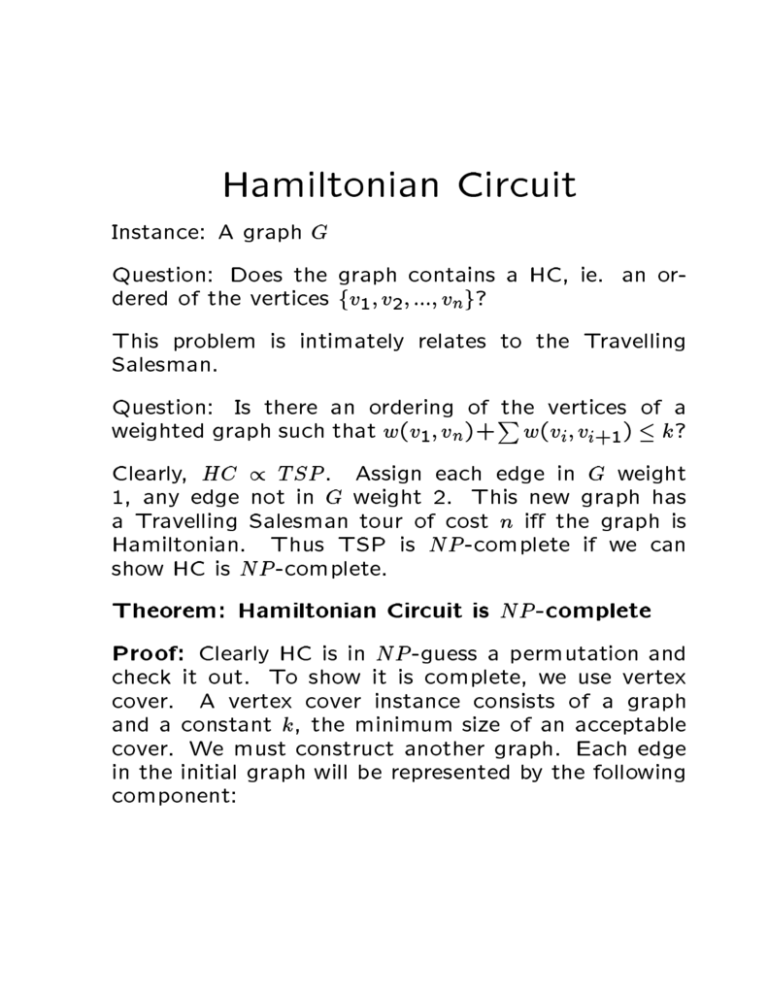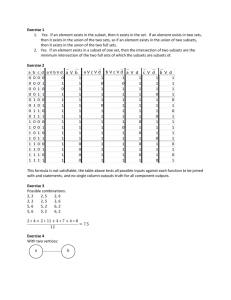Hamiltonian Circuit P
advertisement

Hamiltonian Circuit
Instance: A graph G
Question: Does the graph contains a HC, ie. an ordered of the vertices fv1 v2 ::: v g?
This problem is intimately relates to the Travelling
Salesman.
Question: Is there an ordering of P
the vertices of a
weighted graph such that w(v1 v )+ w(v v +1) k?
Clearly, HC / TSP . Assign each edge in G weight
1, any edge not in G weight 2. This new graph has
a Travelling Salesman tour of cost n i
the graph is
Hamiltonian. Thus TSP is NP -complete if we can
show HC is NP -complete.
n
n
i
i
Theorem: Hamiltonian Circuit is NP -complete
Proof: Clearly HC is in NP -guess a permutation and
check it out. To show it is complete, we use vertex
cover. A vertex cover instance consists of a graph
and a constant k, the minimum size of an acceptable
cover. We must construct another graph. Each edge
in the initial graph will be represented by the following
component:
u
v
u1
v1
u6
v6
All further connections to this gadget will be through
vertices v1, v6, u1 and u6. The key observation about
this gadget is that there are only 3 ways to traverse all
the vertices:
Note that in each case, we exit out the same side we
entered. Each side of each edge gadget is associated
with a vertex. Assuming some arbitrary order to the
edges incident on a particular vertex, we can link successive gadgets by edges forming a chain of gadgets.
Doing this for all vertices in the original graph creates
n intertwined chains with n entry points and n exits.
v1
v2
v3
v3
v2
v4
...
v1
vk
v4
vk
Thus we have encoded the information about the initial
graph. What about k? We set up k additional vertices
and connect each of these to the n start points and n
end points of each chain.
......
N
K
N
Total size of new graph: GE + K vertices and 12E +
2kN + 2E edges ! construction is polynomial in size
and time.
We claim this graph has a HC i
G has a V C of size
k.
1. Suppose fv1 v2 ::: v g is a HC .
Assume it starts at one of the k selector vertices. It
must then go through one of the chains of gadgets
until it reaches a di
erent selector vertex.
Since the tour is a HC , all gadgets are traversal.
The k chains correspond to the vertices in the
cover.
Note that if both vertices associated with an edge
are in the cover, the gadget will be traversal in two
pieces - otherwise one chain suces.
To avoid visiting a vertex more than once, each
chain is associated with a selector vertex.
2. Now suppose we have a vertex cover of size k.
We can always add more vertices to the cover to
bring it up to size k.
n
For each vertex in the cover, start traversing the
chain. At each entry point to a gadget, check if
the other vertex is in the cover and traverse the
gadget accordingly.
Select the selector edges to complete the circuit.
Neat, sweet, and NP-complete.
To show that Longest Path or Hamiltonian Path is NP complete, add start and stop vertices and distinguish
the rst and last selector vertices.
Start
k-1
selector
vertices
Stop
This has a Hamiltonian path from start to stop i
the
original graph has a vertex cover of size k.
Other NP -complete Problems
Partition - can you partition n integer into two
subsets so that the sums of the subset are equal?
Bin Packing - how many bins of a given size do
you need to hold n items of variable size?
Chromatic Number - how many colors do you need
to color a graph?
N N checkers - does black have a forced win
from a given position?
Scheduling, Code Optimization, Permanent Evaluation, Quadratic Programming, etc.
Open: Graph Isomorphism, Composite Number, Minimum Length Triangulation.
36.5-5 Prove that Hamiltonian Path is NP -complete.
This is not a special case of Hamiltonian Cycle! (G
may have a HP but not cycle)
the cleanest proof modies the V C and HC reduction
I gave in class:
Start
k-1
selector
vertices
Stop
This has a Hamiltown path from start to stop
iff the orignal graph had a vertex cover of size k.
The easiest argument says that G contains a HP but
no HC i
(x y) in G such that2 adding edge (x y) to G
causes to have a HC, so O(n ) calls to a HC function
solves HP.
Polynomial or Exponential?
Just changing a problem a little can make the di
erence
between it being in P or NP -complete:
P
NP -complete
Shortest Path
Longest Path
Eulerian Circuit Hamiltonian Circuit
Edge Cover
Vertex Cover
The rst thing you should do when you suspect a problem might be NP-complete is look in Garey and Johnson, Computers and Intractability. It contains a list of
several hundred problems known to be NP -complete.
Either what you are looking for will be there or you
might nd a closely related problem to use in a reduction.
Techniques for Proving
NP -completeness
1. Restriction - Show that a special case of the problem you are interested in is NP -complete. For
example, the problem of nding a path of length
k is really Hamiltonian Path.
2. Local Replacement - Make local changes to the
structure. An example is the reduction SAT /
3 ; SAT . Another example is showing isomorphism
is no easier for bipartite graphs:
For any graph, replacing an edge with makes it
bipartite.
3. Component Design - These are the ugly, elaborate
constructions
The Art of Proving Hardness
Proving that problems are hard is an skill. Once you
get the hang of it, it is surprisingly straightforward and
pleasurable to do. Indeed, the dirty little secret of NPcompleteness proofs is that they are usually easier to
recreate than explain, in the same way that it is usually
easier to rewrite old code than the try to understand
it.
I o
er the following advice to those needing to prove
the hardness of a given problem:
Make your source problem as simple (ie. restricted)
as possible.
Never use the general traveling salesman problem
(TSP) as a target problem. Instead, use TSP
on instances restricted to the triangle inequality.
Better, use Hamiltonian cycle, ie. where all the
weights are 1 or 1. Even better, use Hamiltonian
path instead of cycle. Best of all, use Hamiltonian path on directed, planar graphs where each
vertex has total degree 3. All of these problems
are equally hard, and the more you can restrict
the problem you are reducing, the less work your
reduction has to do.
Make your target problem as hard as possible.
Don't be afraid to add extra constraints or freedoms in order to make your problem more general
(at least temporarily).
Select the right source problem for the right reason.
Selecting the right source problem makes a big
di
erence is how dicult it is to prove a problem
hard. This is the rst and easiest place to go
wrong.
I usually consider four and only four problems as
candidates for my hard source problem. Limiting
them to four means that I know a lot about these
problems { which variants of these problems are
hard and which are soft. My favorites are:
{ 3-Sat { that old reliable: : : When none of the
three problems below seem appropriate, I go
back to the source.
{ Integer partition { the one and only choice for
problems whose hardness seems to require using large numbers.
{ Vertex cover { for any graph problems whose
hardness depends upon selection. Chromatic
number, clique, and independent set all involve
trying to select the correct subset of vertices
or edges.
{ Hamiltonian path { for any graph problems
whose hardness depends upon ordering. If you
are trying to route or schedule something, this
is likely your lever.
Amplify the penalties for making the undesired
transition.
You are trying to translate one problem into another, while making them stay the same as much
as possible. The easiest way to do this is to be
bold with your penalties, to punish anyone trying
to deviate from your proposed solution. \If you
pick this, then you have to pick up this huge set
which dooms you to lose." The sharper the consequences for doing what is undesired, the easier
it is to prove if and only if.
Think strategically at a high level, then build gadgets to enforce tactics.
You should be asking these kinds of questions.
\How can I force that either A or B but not both
are chosen?" \How can I force that A is taken
before B?" \How can I clean up the things I did
not select?"
Alternate between looking for an algorithm or a
reduction if you get stuck.
Sometimes the reason you cannot prove hardness
is that there is an ecient algorithm to solve your
problem! When you can't prove hardness, it likely
pays to change your thinking at least for a little
while to keep you honest.
Now watch me try it!
To demonstrate how one goes about proving a problem
hard, I accept the challenge of showing how a proof can
be built on the y.
I need a volunteer to pick a random problem from the
400+ hard problems in the back of Garey and Johnson.
Dealing with NP -complete
Problems
Option 1: Algorithm fast in the
Average case
Examples are Branch-and-bound for the Traveling Salesman Problem, backtracking algorithms, etc.
Option 2: Heuristics
Heuristics are rules of thumb fast methods to nd a
solution with no requirement that it be the best one.
Note that the theory of NP -completeness does not
stipulate that it is hard to get close to the answer,
only that it is hard to get the optimal answer.
Often, we can prove performance bounds on heuristics,
that the resulting answer is within C times that of the
optimal one.









